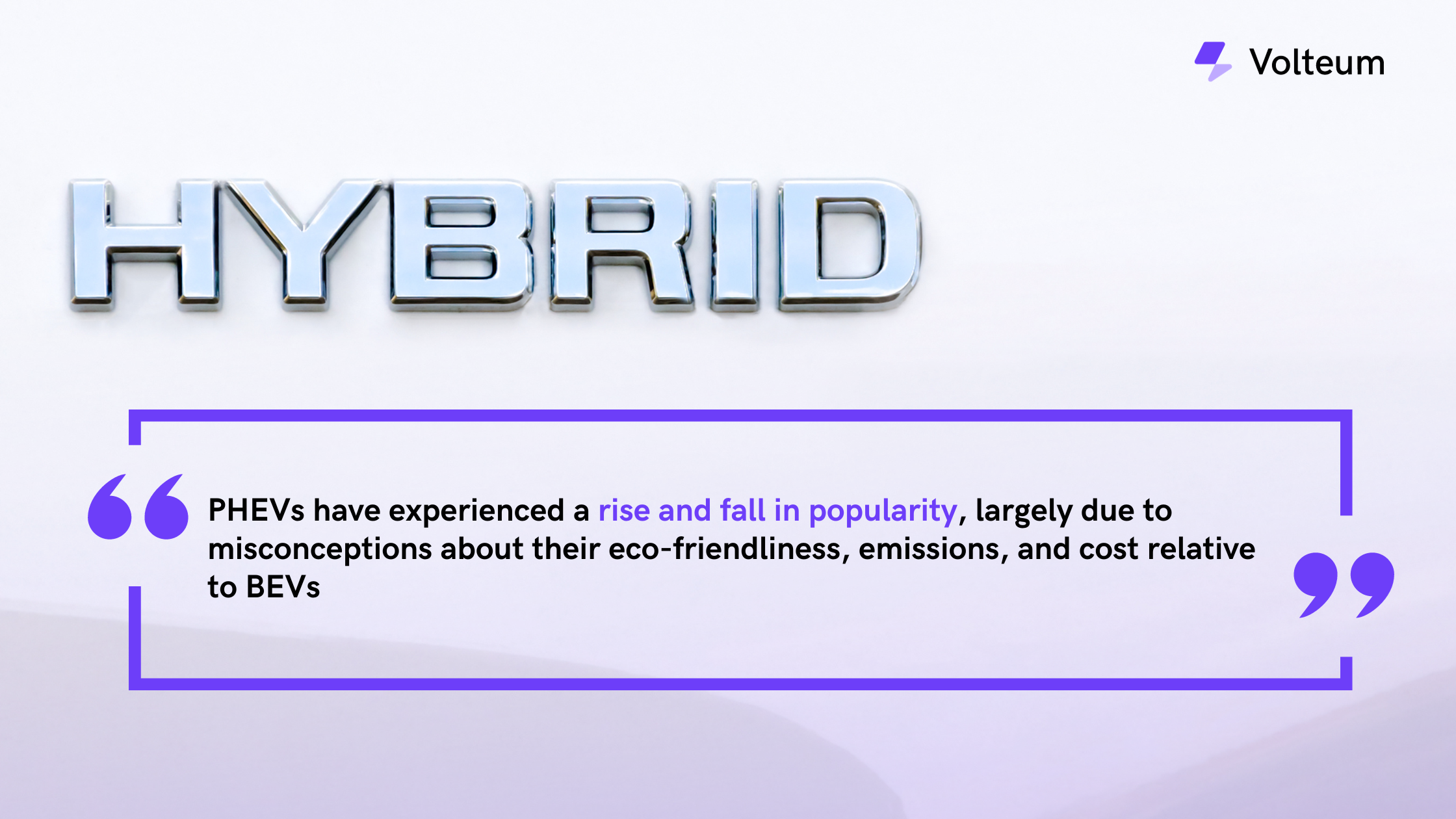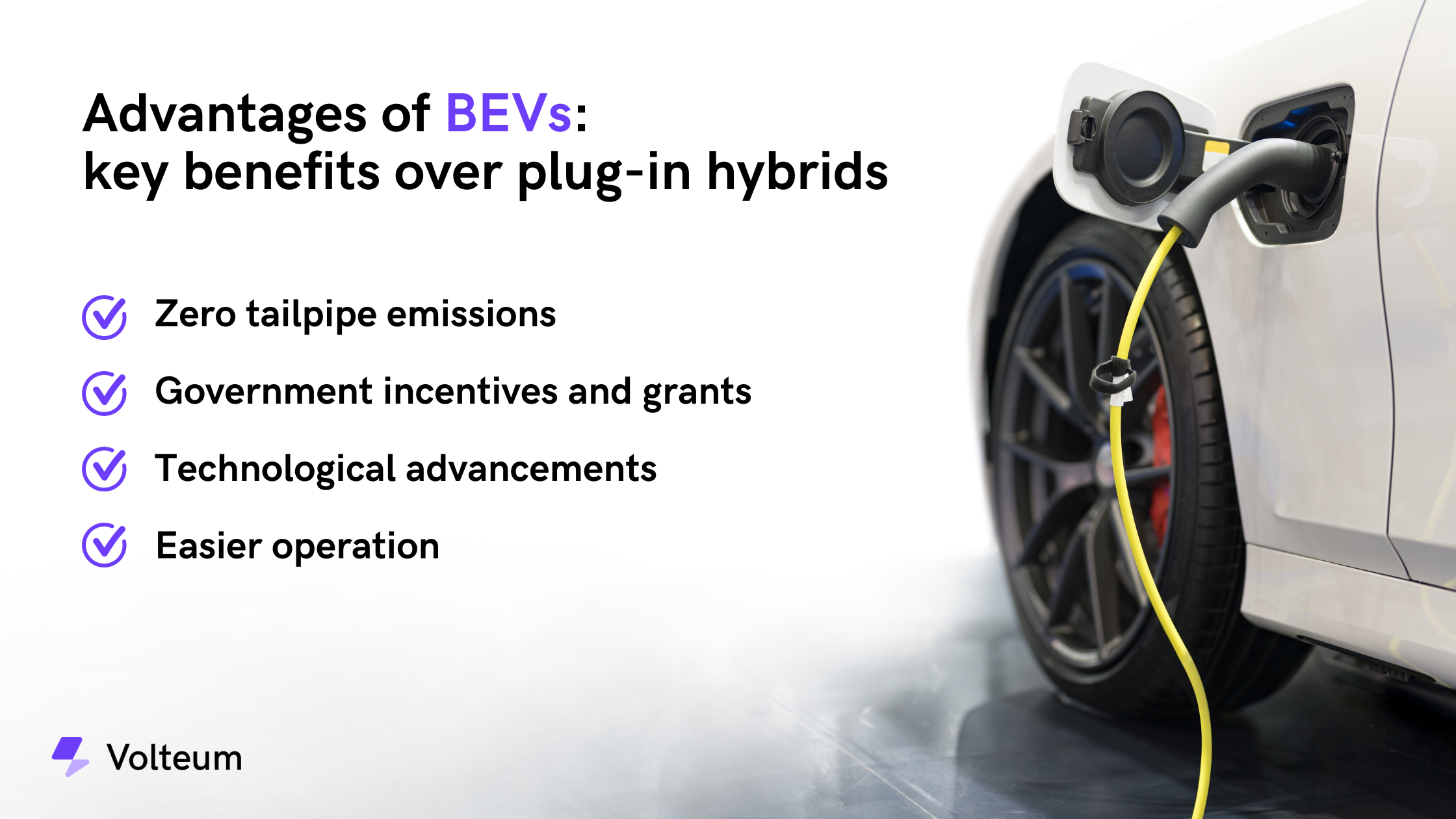PHEVs vs. BEVs: The changing dynamics of the electric vehicle market
Oct 01, 2023 · 7 min read · blog
Plug-in hybrid electric vehicles (PHEVs) have been considered as the bridge between traditional internal combustion engine vehicles and the future of motoring - battery electric vehicles (BEVs). By definition, PHEVs are vehicles that combine a gasoline engine with an electric motor and a rechargeable battery. They can be plugged into an outlet to recharge their batteries, allowing them to run on electricity for short distances before the gasoline engine kicks in. As such, they have been seen as a stepping stone for many motorists, offering a taste of electric driving without the range anxiety often associated with BEVs. However, as we delve deeper into this technology, it becomes clear that PHEVs may not be as environmentally friendly or cost-effective as they initially appear.

PHEVs' journey from popularity to decline

PHEVs have experienced a rise and fall in popularity, largely due to misconceptions about their eco-friendliness, emissions, and cost relative to BEVs. Many believe PHEVs to be a greener choice due to their ability to run on electricity for short trips, thereby reducing their emissions. However, research has shown that while PHEVs do emit less CO2 than conventional cars when driving in electric mode, their emissions can be quite high when the gasoline engine is in use.
Furthermore, the cheaper purchase price of PHEVs compared to BEVs often lures consumers. Yet, when considering the total cost of ownership, including fuel, maintenance, and potential battery replacement costs, PHEVs can end up being more expensive. Despite these drawbacks, PHEVs have played a vital role as a transitional technology, allowing consumers to gradually adapt to electric driving.

Common misunderstandings about PHEVs

The history of PHEVs is a tale of evolution and adaptation, marked by both successes and challenges. However, despite advancements in PHEV technology, their market share has been declining compared to BEVs. This trend can be attributed to several factors, including improvements in BEV technology that have resulted in longer ranges and faster charging times, making BEVs more appealing to consumers.
Moreover, the perception of PHEVs as a 'best of both worlds' solution has been challenged by the reality of their performance. Though they promise the flexibility of gasoline engines for long trips and the benefits of electric power for short ones, many PHEVs spend more time running on gasoline than electricity. This is due to various reasons, such as the lack of charging infrastructure or the drivers' habits, leading to higher emissions than those officially reported.



The environmental dilemma of PHEVs

PHEVs present a mixed bag when it comes to environmental impact. While they can run on electric power alone for short distances, reducing their greenhouse gas emissions during these trips, their overall emissions profile heavily depends on how they are used. If the vehicle is frequently driven in gasoline mode, its real-world emissions can be significantly higher than the reported figures. This discrepancy between official emissions data and real-world performance has raised questions about the true environmental impact of PHEVs.
Moreover, the sustainability of PHEVs is undermined by their continued reliance on fossil fuels. Even though they can run on electricity for part of the time, they still need gasoline for longer trips. As such, they face challenges in meeting long-term sustainability goals, which call for a complete transition away from fossil fuels.

Government policies and bans: steering away from PHEVs

The future of PHEVs is also being shaped by government policies. In recent years, several regions have implemented or announced plans to ban the sale of new PHEVs. For example, the European Union has endorsed a proposal to ban new PHEVs by 2035 as part of its strategy to reduce greenhouse gas emissions. The United Kingdom is even more ambitious, with plans to phase out new PHEVs by 2030.
These policy decisions reflect a growing consensus among policymakers that BEVs are the future of sustainable transportation. They also signal a shift in strategy, from promoting PHEVs as a bridge technology to focusing on accelerating the adoption of BEVs.

Advantages of BEVs: key benefits over plug-in hybrids

Against this backdrop, BEVs offer several advantages over PHEVs.
- First and foremost, they produce zero tailpipe emissions, making them a more sustainable choice for personal transportation.
- Additionally, many governments offer incentives and grants for buying BEVs, which can help offset their higher upfront cost.
- Technological advancements are also making BEVs more appealing. Improvements in battery technology are leading to longer ranges, reducing the range anxiety that has been a major barrier to BEV adoption.
- At the same time, investments in charging infrastructure are making it easier to own and operate a BEV. As more fast-charging stations are being built, and home charging solutions become more affordable, the convenience of charging a BEV is increasing.



Why businesses are electrifying their fleets with BEVs

In light of the number of benefits BEVs provide, there is a strong business case for the electrification of company fleets.
- Transitioning to BEVs can considerably reduce a company's carbon footprint, aligning with corporate sustainability goals and demonstrating environmental responsibility.
- Moreover, the lower operating costs of BEVs, including reduced fuel and maintenance expenses, can result in significant cost savings over the vehicle's lifecycle.
- Government incentives for BEVs further enhance their financial appeal.
- Lastly, by adopting BEVs, companies position themselves at the forefront of technology, showcasing forward-thinking and innovative corporate values to stakeholders, partners, and customers.
Thus, the switch to electric is not just an environmentally conscious move, but a strategic decision that bolsters both the bottom line and company reputation.

Conclusion

In conclusion, while PHEVs have played an important role in the transition towards electric vehicles, their limitations in terms of emissions and efficiency, along with advancements in BEV technology, are leading to their decline. As we think about the future of transportation, it is important to critically examine our assumptions and expectations about different technologies.
Choosing the right vehicle involves considering not only our personal needs and budget but also the environmental impact of our choices. With ongoing improvements in BEV technology and supportive government policies, BEVs appear to be the most promising pathway towards sustainable transportation. As such, the fall of PHEVs may be seen not as a failure, but as a necessary step in our journey towards a cleaner, greener future.

Are you ready to discuss more in detail how Volteum can help electrify and optimize your fleet? Book a demo and try the world's leading electrification and EV fleet software today ➡️ https://bit.ly/volteumdemo
